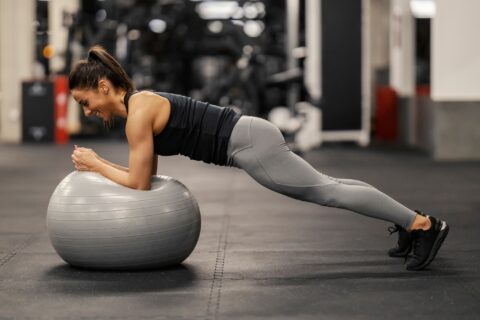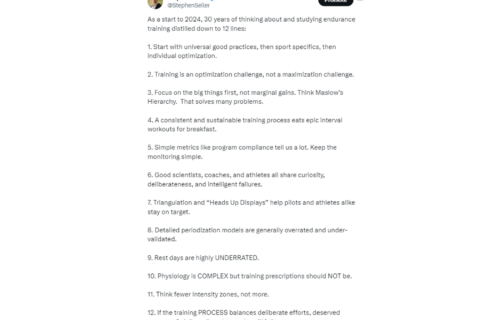Trevor Connor and Rob Pickels run through one of their favorite sprint workouts, and share some helpful tips and tricks.
Video Transcript
Trevor Connor 00:00
For some people, sprinting is their bread and butter. For other people it’s just a necessary evil. But everyone can see some benefits from sprint training if you’re willing to put in the time.
Rob Pickels 00:09
Am I seeing the gains yet?
Trevor Connor 00:11
Not yet, Rob, a few more miles.
Rob Pickels 00:28
This is a short but tough workout.
What you will gain from this sprint workout?
Trevor Connor 00:30
You’re not going to accumulate a lot of TSS, but you are going to feel it the next day. Fortunately, you’ll also notice it in the races. These intervals can really turn your form around fast, you can pretty much see all the gains in just a couple of weeks.
Rob Pickels 00:44
These are going to build your anaerobic power. That’s your race-ending sprint, your jump, and your attack.
Trevor Connor 00:50
But don’t be surprised if you all see that little extra kick to your aerobic fitness.
Rob Pickels 00:54
Keep in mind, this isn’t a pure sprint workout. If you’re looking to build your race-ending kick, then you’re going to want to focus on even shorter efforts.
Trevor Connor 01:01
I only use these during the race season.
Rob Pickels 01:03
As a final prep before you’re looking to be in peak form, or after a setback, they’re a good way to bring back race fitness fast.
Where and how to perform this sprint workout
Rob Pickels 01:10
You need to do this somewhere safe. Most of the time when we’re sprinting, we’re not able to pay close attention to the road. So you have to look for a stretch that’s straight, has no obstacles, and good pavement. You’re going to be going all-out, so we want to avoid traffic and roads with turns.
Trevor Connor 01:26
I would use about a 4 to 6% grade for these sprints. That keeps the speed down, which makes it a little bit safer, and also allows the time between the sprints to be a true recovery because you can just turn around and coast down that hill. There are three variations on this workout. I personally like to mix them up, but you don’t have to.
Rob Pickels 01:42
Do one set of each or just the first two if you’re looking for a shorter workout.
Trevor Connor 01:47
There’s a little counterintuitive, but if you’re a non-sprinter, you’re going to be able to get through all three sets without too much trouble.
Rob Pickels 01:54
But, if you’re more of a pure sprinter, you should probably only do one or two sets because these are going to tear your legs up.
The 3 variations of this sprint workout
Trevor Connor 02:00
And remember at least 10 minutes rest in between each set. This first variation is the hardest, so I like to do this one first while my legs are fresh. And something really important to remember that applies to all these different variations is make sure you have at least two minutes full rest in between each and every single sprint.
1st variation
Trevor Connor 02:21
You’re going to start with two 20-second sprints to basically warm up your legs, then you hit the hard part. You’re going to do three 40-second sprints in a row and these are tough. You’re going to think you have five seconds left when you’re only at that 20-second mark, and you’ve got to figure out how to get another 20 seconds out of your legs. Then, after you’ve done your three 40-second sprints, again, take two minutes rest, then you’re going to do two 30-second sprints with two minutes rest again. Then, take a full rest before you attempt your next set.
2nd variation
Rob Pickels 02:52
The second variation is variable cadence sprints. You’re going to perform eight reps of 20 seconds with two minutes rest. Each effort is all-out. Do the first sprint in a gear that’s a little bit too easy, for example, your 39-15. Then shift to a gear that’s harder for the next three, until you’re in a gear that feels too hard. Stay in that gear for the fifth effort, and then shift to your easier gears as you ramp back up to number eight. Remember, this workout is done well if your first rep feels too easy and your middle rep feels like a gear that’s too hard.
3rd variation
Trevor Connor 03:30
This last variation is optional, meaning if I’m only going to do two sets in a sprint workout, this is the one I’m going to skip. If I am going to do it, it’s going to be that third and final set. This is as close as you can get to doing strength training on a bike. First, you’re going to need a relatively steep climb, at least something with a 6% grade. Then what you’re going to do is eight 20-second sprints, again separated by two minutes, but you are going to do these in as big a gear as you can. I like to try to do these in a 53-11. When you are starting out, you are barely turning those cranks over, like 15-20 rpm, and the whole point of the sprint is just to try to get those gears over as hard and as fast as you can.
Tips to have a great workout
Rob Pickels 04:09
Here are some tips to have a great workout. First, always use the same starting line.
Trevor Connor 04:16
But use a slow rolling start.
Rob Pickels 04:18
Focus on recovery. Take a full two minutes, no pedaling.
Trevor Connor 04:22
Treat every sprint like you are sprinting for your best power ever.
Rob Pickels 04:26
Focus on your form for max power.
Trevor Connor 04:28
Don’t shift on any of these sprints, except for maybe the 40-second sprints in that first variation.
Rob Pickels 04:34
And most importantly, before you turn around, always look for cars. This workout should only take about an hour, maybe less if you’re only doing two sets.
Trevor Connor 04:45
Keep it short, quick warm-up, do the workout, get home.



